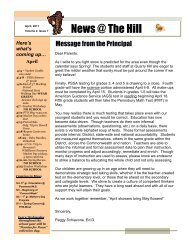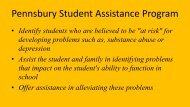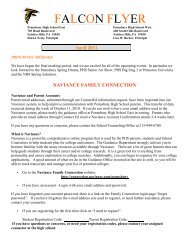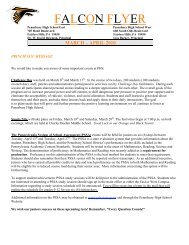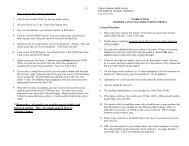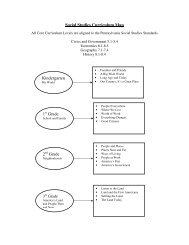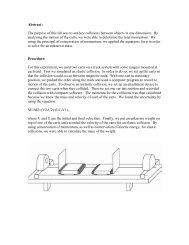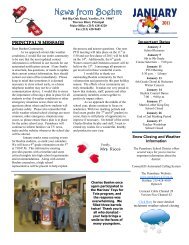K-8 Gifted Program Quality Review - Pennsbury School District
K-8 Gifted Program Quality Review - Pennsbury School District
K-8 Gifted Program Quality Review - Pennsbury School District
Create successful ePaper yourself
Turn your PDF publications into a flip-book with our unique Google optimized e-Paper software.
Question #1: Screening and Identification of <strong>Gifted</strong> Students<br />
To what extent are screening, identification and placement procedures for the gifted<br />
adhering to Chapter 16 Regulations and requirements?<br />
Narrative Findings<br />
In light of PDE Chapter 16 revisions and the changing requirements for screening and<br />
identification of gifted students, the <strong>Pennsbury</strong> <strong>School</strong> <strong>District</strong> has taken steps over the past years,<br />
to bring its procedures in compliance with these regulations. At present, there is an updated<br />
elementary level <strong>Gifted</strong> Multiple Criteria Assessment matrix in place, the GMCA. This matrix<br />
assesses all elementary students, as a first step, for screening and identifying potentially gifted<br />
students by using standardized achievement data from two tests: CogAT and the ITBS. These<br />
tests are administered at the end of 2 nd grade. The review committee found no universal<br />
screening procedure or assessment in place for locating K-2 nd grade gifted students.<br />
The evaluation team found some inconsistency among the elementary schools in the use of<br />
criteria for selection of students to be screened. In addition, the agreed on total points of the<br />
matrix set as the prerequisite for eligibility as a mentally gifted student are not consistently<br />
followed. These decisions or exceptions do not appear to be ordinarily made by the <strong>Gifted</strong><br />
Multidisciplinary Team [GMDT].<br />
For the next phase of the screening and identification process, the <strong>School</strong> <strong>District</strong> uses several<br />
assessments, screening instruments, teacher and parent rating forms, an abbreviated version of<br />
the Chuska Rates of Acquisition and Retention form, and the WISC-IV. The five multiple<br />
criteria, other than I.Q., as described and required in Chapter 16, do not seem to play a large role<br />
towards enlarging the scope of eligible students in need of a <strong>Gifted</strong> Individualized Education<br />
Plan (GIEP). Such focus would enhance the likelihood of reducing the disparity of numbers of<br />
students identified as gifted between schools with different socio-economic populations.<br />
Teachers and other staff are not always clear or conversant with the <strong>District</strong> screening and<br />
identification procedures. They are unsure about what to tell parents regarding how to initiate a<br />
request for gifted education placement, or what role parents play in this process. In many cases,<br />
classroom teachers do not appear to have a firm understanding of what characterizes academic<br />
giftedness and its learning implications. Teachers and principals expressed interest in learning<br />
more about the gifted child’s social, emotional, and intellectual behaviors, and how to meet these<br />
student’s unique needs in their classrooms.<br />
Parents voice concern, and note lack of communication about the <strong>District</strong>’s procedures and<br />
requirements for screening, identification, and decision criteria for determining final placement.<br />
They are confused about the GIEP process; their role in student placement; and to what extent<br />
student assessment data is considered or used for instruction across content areas. Also, of note<br />
from parents’ comments, is that parents and their children are not always informed beforehand<br />
regarding the day or time the WISC-IV assessment will be administered.<br />
6




